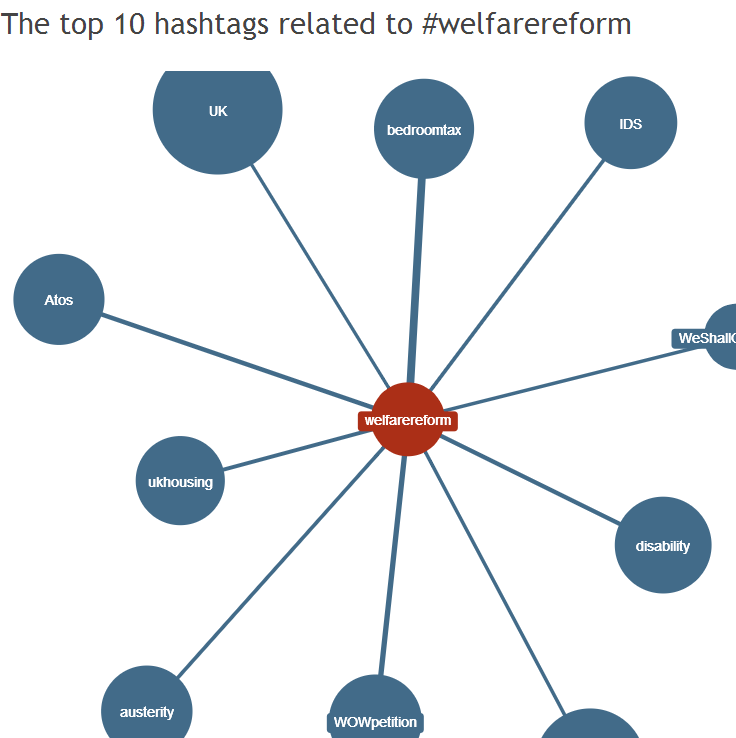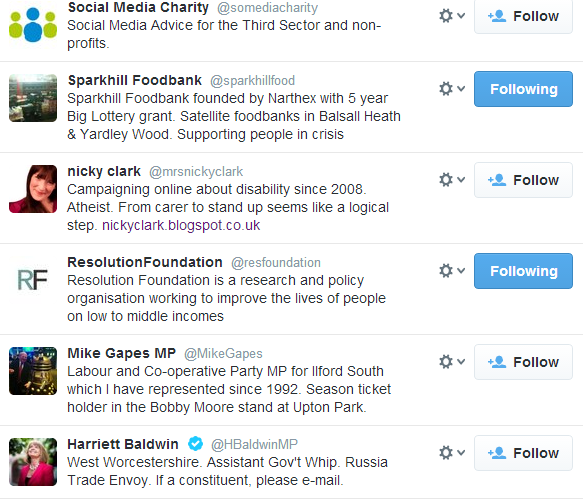We’ve been compiling a list of people on Twitter to follow on welfare-related issues. Here’s how we did it:
(If you need to know how to create a Twitter list, see Twitter’s guide)
1. Search Twitter biographies only
The quickest way to kick off your Twitter list is to search Twitter biographies for users who mention the areas you’re interested in.
Twitter tool FollowerWonk has a facility for searching biographies on the site – make sure you select “search Twitter bios only” from the drop-down menu.
Try a range of terms: ‘welfare’ is normally used by those in official positions (or ‘social security’ in the US); ‘housing’ is a more specific term, as is ‘homeless’ or ‘homelessness’, ‘poverty’ and even ‘social’ (as in ‘social inclusion’).
You might want to look for users who mention an interest in specific issues like ‘bedroom tax’ or ‘workfare’, too, or organisations like Atos, A4e, and DWP.
For search methods and similar tools read this post on Search Engine People.
2. Browse Twitter directories
There are a number of directories for Twitter users. WeFollow works well with a general search for welfare but adding location seems to exclude a lot of relevant results.
Twellow allows you to narrow down to the United Kingdom, and particular cities, which helps exclude US results, but there doesn’t appear to be a way to use keywords and location together.
There are categories but these are very US-centric – so, no welfare or benefits, and the categories for ‘low cost housing’ and ‘affordable housing‘ bring up too many irrelevant results.
If you find a more effective directory please let us know!
3. Find related lists
It’s likely that someone else has already created a Twitter list covering the same or a related area. One way to find these is to look at the users you’ve already found and see what lists they’ve been added to.
You can find these by going to the Twitter user’s profile page and clicking on Lists to the left and then selecting Member of in the middle. The resulting URL should look like this:
https://twitter.com/USERNAME/memberships
…but with the username instead of USERNAME. Shiv Malik‘s list memberships, for example can be found at https://twitter.com/shivmalik1/memberships
You can also try to search Twitter lists. However, a number of tools that used to allow you to search these are no longer operating, so you’ll have to resort to some clever use of Google.
Try the following search:
site:twitter.com/*/lists/ inurl:YOURKEYWORD
…and replace YOURKEYWORD with what you’re looking for (note that there is no space after the colon).
For example, with the keyword welfare it would look like this:
site:twitter.com/*/lists/ inurl:welfare
Sadly that only produces one result, because the list has to be called ‘welfare’ exactly – so this list wouldn’t match the search.
You can try omitting the “lists” part and using wildcards (asterisks) around your key term instead:
inurl:twitter.com/ inurl:/*welfare*
Or try broadening the search to something like this (replacing the phrase with your own):
site:twitter.com/*/lists/ "bedroom tax"
This will bring back any list pages where one of the tweets mentions that term. Obviously this depends on what people are tweeting about at that moment in time.
4. Search discussions and hashtags
As you start to follow people in your field, you’ll come across some terms and hashtags repeatedly. In welfare for example people will be talking about the bedroom tax, welfare reform, universal credit, housing, benefits, and other issues.
You can search for these on Twitter itself, or use Google with the phrase site:twitter.com (note no space after the colon) which limits results to Twitter.
Make sure you use quotes to get exact phrases only – e.g. “bedroom tax” will ensure you don’t get results that mention both words in separate places.
Hashtags of the same phrases are worth trying too: #bedroomtax and #welfarereform, for example are both widely used instead of the full phrase.
You can also try prefixing general terms with ‘uk’ – #ukhousing, for example, is often used by those within the UK housing industry to distinguish their discussions from those elsewhere.
Watch out for scheduled live chats too – #CABlive, for example, is used for discussions between citizens advice bureaus – and campaigns, like #PaydayWatch.
After your initial search it’s worth trying again occasionally – you can set up regular updates for a search using Twitter tools like Tweetdeck.
You can also use a tool like Hashtagify.me to find hashtags related to ones you already know.

5. Following followers
Finally, look at the people you’ve already found and who they’re following and listing.
When you’re logged in to the Twitter website it normally shows a box on each profile page showing ‘similar accounts’, but clicking on ‘Following’ and ‘Followers’ will give you more suggestions – or you can just add those words to the Twitter account URL: a list of accounts that Patrick Butler is following can be found at https://twitter.com/patrickjbutler/following, for example

Do you have any other tips on finding relevant Twitter accounts to follow? Please let us know in the comments on @hmiwelfare